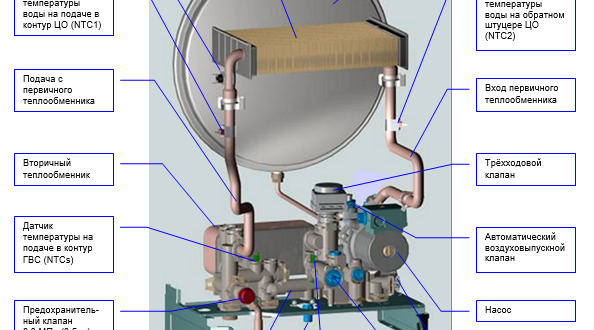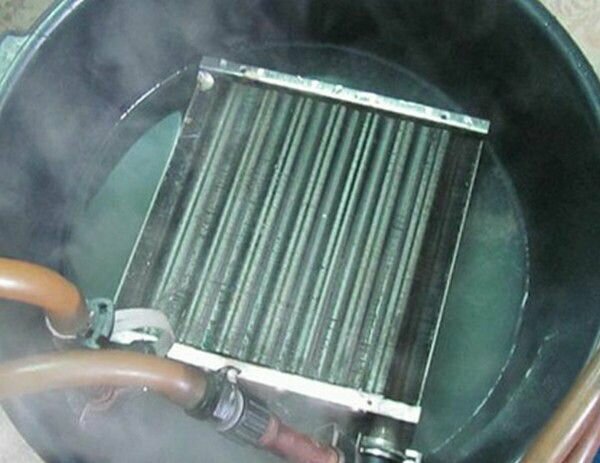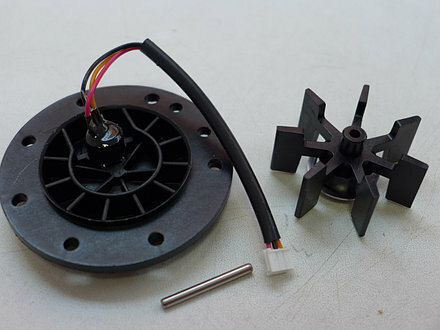Installation of a double-circuit gas boiler allows you to effectively solve the issue of hot water supply. But what if the hot water in the gas boiler does not turn on? Agree that you shouldn't immediately panic and call the rescue service or service center.
We will get acquainted with the principle of operation of a double-circuit boiler, we will talk about the reasons that can lead to the interruption of hot water supply and how to eliminate the problems that have arisen.
Understanding the essence of the equipment operation, you can not only independently identify the reasons for the failure in operation, but also eliminate most faults, as well as restore the hot water supply in full volume.
The content of the article:
-
The principle of operation of a double-circuit gas boiler
- Distinctive schemes for the operation of double-circuit boilers
- Natural and forced circulation system
-
What if the boiler does not heat water?
- Clogged secondary heat exchanger
- Problems with the flow sensor
- DHW temperature sensor malfunction
- Problems in the operation of the three-way valve
- Conclusions and useful video on the topic
The principle of operation of a double-circuit gas boiler
To understand why the gas boiler began to heat water poorly or there is no hot water supply at all, you need to understand how it works double-circuit unit. Almost any gas equipment of this type is equipped with several units.
In the main unit, the gas mixture is ignited and burned. An additional water unit provides the level of hot water supply, and monitors the pressure in the line. The smoke extraction unit is responsible for the removal of combustion products outside the housing.
When the equipment is started, the pump is activated, pumping water into the system. The liquid begins to circulate through the tubes of the heat exchanger, where it warms up evenly due to the effect of the burner.

The boiler has two circuits, one of which is responsible for heating, and the second for the operation of DHW. Simultaneous operation of two circuits is impossible
The heating process is controlled sensors or a simple mechanical system or gas boiler automation, depending on the model and complexity of the device. When the set temperature is reached, the gas supply stops. When the temperature drops to a critical value, the burner starts up and the cycle repeats.
Distinctive schemes for the operation of double-circuit boilers
In case of problems with hot water supply, in order to find out the reasons, it is necessary to understand the scheme of operation of the gas unit in the DHW mode. There are two options with bithermic and secondary heat exchanger.
Boiler with bithermic heat exchanger
The principle of operation of a unit with a bithermal heat exchanger is related to the configuration - in fact, it is one tube of complex shape located inside another. The coolant moves along the outer section of the tube, and DHW water moves along the inner section.
When operating in heating mode, the burner provides heating of the coolant to the set temperature and turns off. When the hot water tap is opened, the liquid begins to flow along the internal circuit of the heat exchanger, at the same time the blocking valve of the external circuit is closed.

In double-circuit boilers with a bithermal heat exchanger, one heat exchanger simultaneously contains the internal and external circuits responsible for the operation of heating and hot water supply
The burner operates continuously at maximum power, providing heating of the running water. After closing the tap, the coolant supply valve opens, and the boiler starts to work in normal mode.
Boiler with secondary heat exchanger
In another type of boilers with a secondary heat exchanger, the principle of operation is slightly different. It is not just the second circuit that is responsible for heating the water, but a separate plate heat exchanger equipped with a three-way valve.

The secondary heat exchanger looks preferable to the bithermic one - it is easier to remove for flushing and cleaning
When the hot water tap is opened, the heat carrier is redirected from one heat exchanger to another, where heat is transferred to the flowing water. At the same time, the pump continues to work, providing pumping of the coolant along a small circuit.
Natural and forced circulation system
The reasons why gas boilers stop heating water may also depend on the way the coolant is circulated. But this is more connected not just with the heating of water, but with the operation of the device itself. The reason for the poor operation of the boiler included in the scheme with natural circulation is either non-observance of slopes or the presence of air locks.
In heating circuits with forced circulation there is no such problem, since the coolant moves through the system under the action of a circulation pump. Further, we will not dwell on the operation of the gas boiler itself, but we will consider exclusively the problems of hot water supply, assuming that the boiler functions normally in heating mode.
What if the boiler does not heat water?
When combining the functions of heating and hot water supply in the boiler, situations often arise when the heating system is working, but there is no hot water. DHW problems can manifest themselves in another form - the volume of heated water may be insufficient or the temperature may be lower than required.
In some cases, a situation may occur when hot or cold water flows from the tap. There is also a reasonable explanation for this, and the reason for this phenomenon is also easily eliminated.
Clogged secondary heat exchanger
Salt buildup in the heat exchanger is the most common cause of reduced DHW efficiency. As a result of scale formation, not only the volume of the heat exchanger decreases, but also a significant decrease in the water temperature.

Scale reduces the volume of fluid permeability along the circuit, and, deposited on the walls of the heat exchanger, reduces its thermal conductivity
This is due to the fact that water is in contact not with the metal of the heat exchanger, but with scale, the thermal conductivity of which is significantly lower. Limescale is very unstable and can crack and flake. Even a small piece or plate of scale can simply block the flow of liquid.
There are two ways to clean the heat exchanger - mechanical and chemical. The first one is very troublesome and its effectiveness is much lower. In addition, in some models, independent dismantling of the heat exchanger can be not only difficult, but also practically impossible.
Chemical cleaning of bithermic heat exchanger
Flushing is carried out without dismantling the heat exchanger; to complete the procedure, a booster with a volume of 20-30 liters is required. Before starting work, it is necessary to drain coolant from the heating system using a Mayevsky crane.
Fill the booster reservoir with flushing solution, and lower the hoses into the reservoir, the free ends of which are connected to the heat exchanger nozzles. The movement of fluid is possible only under the action of a circulation pump, it must be connected to one of the hoses.

The ends of the hoses must be put on the nozzles of the heat exchanger, and the free ends must be placed in a booster with flushing liquid by connecting a circulation pump. Work can be done without removing the heat exchanger
It would be ideal to connect a reversible pump with the ability to change the direction of fluid flow. It remains to start the boiler for heating with a predetermined temperature of 50-60 degrees and leave it for 15 minutes, periodically changing the direction of circulation.
Chemical cleaning of the secondary heat exchanger
The flushing of the secondary heat exchanger of a double-circuit gas boiler can be carried out in the same way as the flushing of a bithermic heat exchanger. However, it should be borne in mind that the secondary heat exchanger can be easily removed, so you can improve the quality of cleaning by dismantling it.
To gain access to the heat exchanger, it is necessary to dismantle the front panel of the unit and move the control box to the side. The heat exchanger is fixed with two bolts at the bottom, which can be removed easily by unscrewing it.
Most efficiently extracted from the original location heat exchanger for flushing place in a container with a solution of salt dissolving and boil. A 20% citric acid solution can be used in place of a suitable household product.

Good results can be achieved if the secondary heat exchanger is boiled in a wash solution.
When cleaning any heat exchanger, at the final stage, rinsing with clean water is carried out. This measure is necessary to remove traces of a chemically aggressive substance and stop its effect on the walls of the heat exchanger.
There is another way to clean the heat exchanger - hydrodynamic. Its implementation requires special equipment and pressure control at each stage of cleaning. Therefore, without special knowledge and skills, performing it on your own can be dangerous.
Regular cleaning of the heat exchanger will avoid the need to use very aggressive compounds and will make it possible to extend its life. It is recommended to clean the heat exchanger annually at the end of the heating season.
Problems with the flow sensor
A possible reason according to which the gas boiler can stop heating water is problems with the flow sensor. The device is a small fan rotating under the action of a stream of water. As a result of rotation, a signal for heating the water is sent to the control board. The fan may stop rotating due to a blockage.
You can remove the blockage without dismantling the device. For cleaning, it is enough to open and close the water tap several times. If such actions do not give the desired result, then you will have to remove the sensor and clean it.
This requires:
- Disconnect the gas boiler from the mains;
- Turn off the water supply tap;
- Drain the water from the unit.
Typically, the flow sensor is attached with a bracket, by removing which, you can easily remove the device. The assembly is removed completely, in order to remove the inner part, it is necessary to turn the parts in the groove. During disassembly, clean the filter mesh and pull out the turbine.
Often, the turbine blades are covered with a layer of rust that needs to be cleaned well. If you remove the three clips, you can remove the turbine itself to clean the inner plane of its landing. Now it remains to assemble in the reverse order.

When disassembling the flow sensor, you need to clean the filter and turbine blades.
If cleaning the flow sensor does not bring the desired result, and there is no hot water, then the entire unit will have to be replaced.
DHW temperature sensor malfunction
The problem manifests itself in the fact that the boiler starts up, but after a few minutes it goes out, giving an error code. This indicates a malfunction of the sensor that determines the temperature of the water supply to the DHW circuit. To find out if the sensor is working properly, it is necessary to measure the resistance with a multimeter.
Looking at the instructions, you need to check the result with the actual temperature of the sensor. If the sensor at room temperature shows a result corresponding to a water temperature of 60 degrees, then it is obvious that the sensor is defective and requires replacement.
Taking into account the fact that the sensor is in direct contact with water, then to replace it, it will be necessary not only to turn off the water supply tap, but also to completely zero the pressure.
Problems in the operation of the three-way valve
If, when you turn on the hot water supply, it is noticeable that the gas boiler does not heat the water very well or the water flows very cold, then this indicates the circulation of the coolant only along the heating circuit. The reason lies in clogging or failure three-way valve.
Typically, the 3-way valve fails due to excessive contamination. In addition, as a result of operation, wear of the rod may occur, failure of the electric motor due to loss of tightness. To remove the three-way valve, you need to disconnect the boiler from the network and drain the water from the system.

You can clean the three-way valve with your own hands; in case of more serious breakdowns, it is better to contact a specialist or make a complete replacement yourself
The problem node must be disconnected from all tubular connections, and all electrical wires must be disconnected. The three-way valve can then be removed for inspection and cleaning. Be aware that some water may spill out when the pipes are disconnected.
Most often, limescale residues are found inside the three-way valve, which interfere with the normal passage of water. After removing them, the device again performs its functions. If the motor that moves the inner ball fails, then it is better not to resort to repairs, but to completely replace the entire assembly.
Conclusions and useful video on the topic
The following video will show you how to clean the flow sensor:
A double-circuit gas boiler is a rather complex device, the repair of which is not always possible with your own hands. But if there are problems with the water supply, then, based on the above material, you can independently identify the cause of the breakdown.
Knowing which components and parts affect the operation of hot water supply and taking appropriate preventive measures in a timely manner, it is possible to ensure long-term and uninterrupted operation of the equipment.
Do you want to talk about how you restored the operation of the hot water preparation circuit with your own hands? Do you have useful information on the topic of the article? Please write your comments in the form below, ask questions, post photos on the topic of the article.


